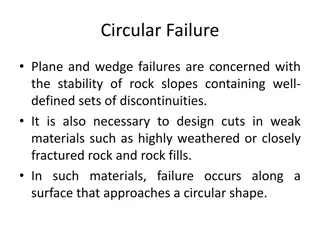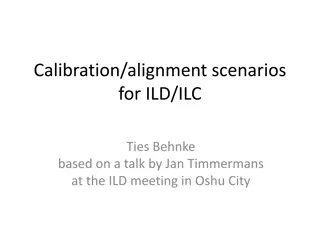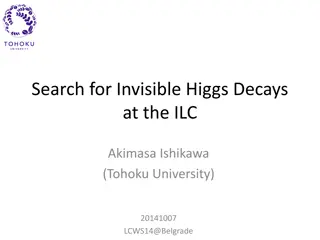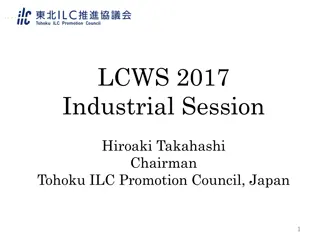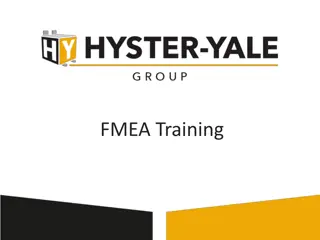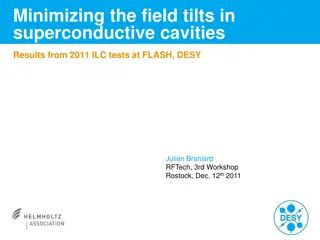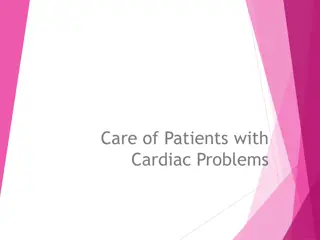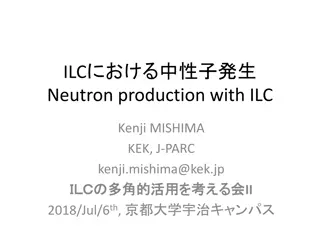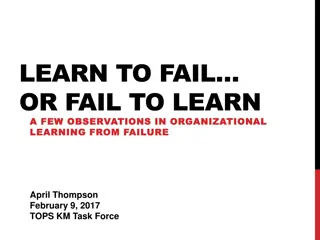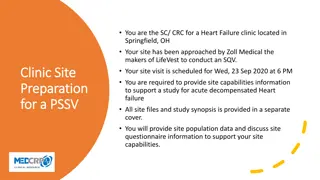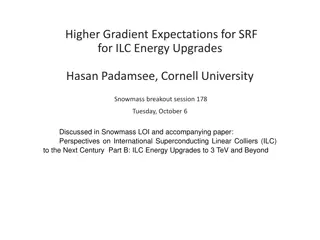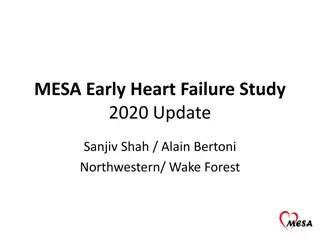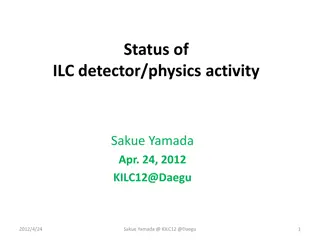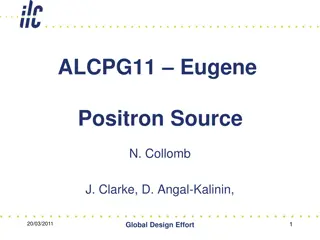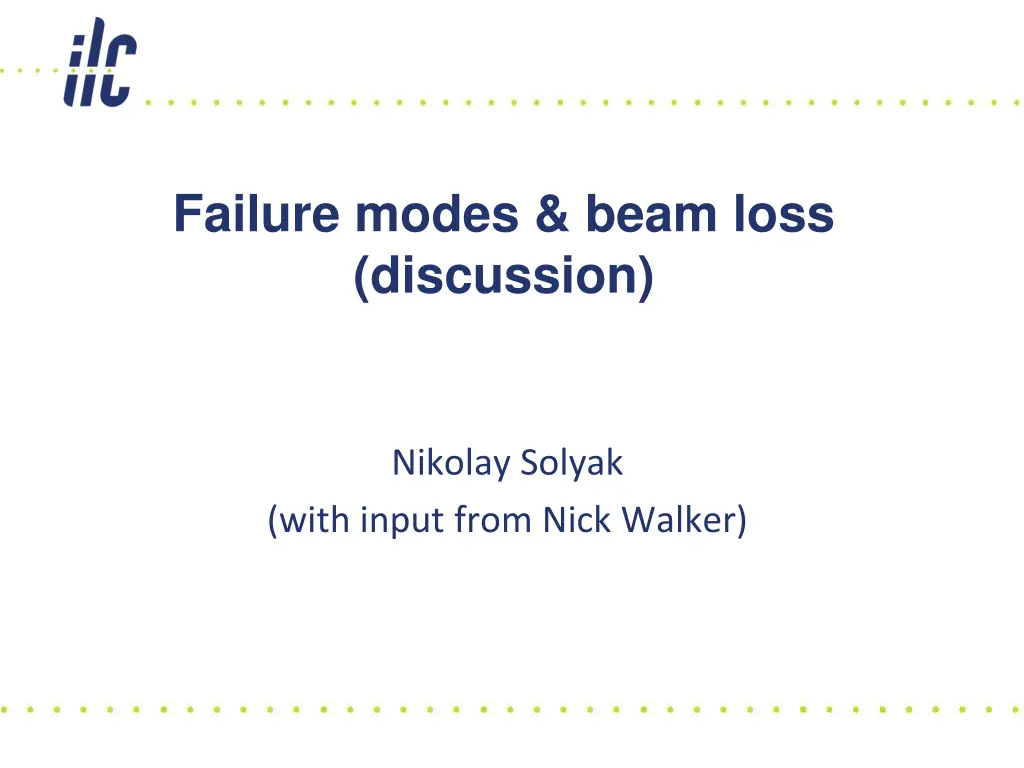
Failure Modes & Beam Loss Discussion - Analysis & Focus
Explore the discussion on failure modes and beam loss in accelerator tunnels, focusing on analyzing potential accidents and consequences to enhance machine protection systems. Gain insights from past studies and current design status of the Machine Protection System (MPS) for the ILC project.
Download Presentation

Please find below an Image/Link to download the presentation.
The content on the website is provided AS IS for your information and personal use only. It may not be sold, licensed, or shared on other websites without obtaining consent from the author. If you encounter any issues during the download, it is possible that the publisher has removed the file from their server.
You are allowed to download the files provided on this website for personal or commercial use, subject to the condition that they are used lawfully. All files are the property of their respective owners.
The content on the website is provided AS IS for your information and personal use only. It may not be sold, licensed, or shared on other websites without obtaining consent from the author.
E N D
Presentation Transcript
Failure modes & beam loss (discussion) Nikolay Solyak (with input from Nick Walker)
ILC schematics Damping Rings Polarised positron source Polarised electron source Ring to Main Linac (RTML) Beam dump Beam Delivery System (BDS) & physics detectors Total length (500 GeV) 30.5 km SCRF ML (RTML) RTML_BC Positron source BDS / IR Damping Rings RTML+ML+BDS ~ 150/300 bunches in a time 22.2 km 2.8 km 1.1 km 4.5 km 3.2 km e- Main Linac (incl. bunch compressor 2 13.12.12 N. Walker ILC PAC TDR review
Failure modes Failure mode analysis became a focus due to the Japanese CFS request to provide some numbers for maximum credible beam loss in the main accelerator tunnel, in order to set the thickness of the dividing concrete wall (cost and space) This is not the first time these subjects have been addressed and there are reports and some failure studies out there. 3 LCWS'14, Belgrad, 10/2014 N.Solyak
Focus for further Failure mode analysis The idea is to look at possible accidents leading to beam loss is part of the process towards answering that request. Clearly the ML is the focus but failure modes and beam loss is necessarily a global problem. First step: Generate a list of what could go wrong (i.e. fail) and what would the consequences be? for each sub-systems. List could become long and detailed, but for now perhaps a high-level list of critical things that can break is a good start. Making such a list inevitably brings up the issue of machine protection system (MPS) and what interlocks we would expect. Need study/simulations of most critical failure modes to provide numbers for max losses in the machine. 4 LCWS'14, Belgrad, 10/2014 N.Solyak
Status of MPS design and past studies ILC MP and availability studies (2006 work package, T.Himel) 10.5 ILC BCD Machine Protection System, M.Ross, (http://docdb.fnal.gov/ILC- public/DocDB/ShowDocument?docid=114) ILC-TRC second report, TRC03C8.pdf TESLA-XFEL MPS (http://flash.desy.de/sites/site_vuvfel/content/e403/e1642/e2410/e2411/infoboxCont ent51201/DESY-THESIS-2009-012_TESLA-FEL_2009-03.pdf) ASTA MPS, http://beamdocs.fnal.gov/AD/DocDB/0045/004520/001/MOPPC071_2.pdf) https://indico.cern.ch/event/185561/ What is new? Level of details is not always sufficient, possible modification (?) New experience/studies became available from existing and designed machines: oLHC, FLASH, ASTA, FERMI, XFEL, CLIC, EES, Need update for site-specific changes (post-TDR) tunnel configuration Most critical failure modes will require beam physics simulations to understand hazards and improve design. 5 LCWS'14, Belgrad, 10/2014 N.Solyak
MPS Scope MPS goals and scope: Protect the accelerator from beam induced damage (single or multi bunch) Safely switch off or reduce beam intensity in case of failures Monitor/control beam/radiation intensity Fail Safe design where possible Provide highest machine availability possible Provide overview of machine status subsystems status (ok/not-ok) Manage and display alarms Performance/fault analysis (i.e. data logging etc.) Determine the operational readiness of the machine 6
MPS Design Considerations Topology of MPS system Layout Base on current ILC layout, MPS will be segmented into several sections to optimize the response times and to deal with the beam dynamics and accelerator component issues specific to each section: Source MPS (e+, e-) Damping Rings MPS e+ & e- Main Linac MPS Bunch Compressors MPS BDS MPS etc. These MPS segments would of course be linked to the a master MPS system MPS Modes must be well defined Beam modes (low/full intensity, ramping-up, e+ production, etc..) Beam intensity limits etc Defined based on Machine states Operational modes Beam path to particular dump locations 7 10/09/2014 Arden Warner
MPS consist of ILC MPS is collection of devices intended to keep the beam from damaging machine components, both the damage caused by a single/few bunch and the residual radiation or heating caused by small (fractional) losses of a many bunches. Consist of: 1) a single bunch damage mitigation system, 2) an average beam loss limiting system, 3) a series of abort kickers and low power dumps, 4) a restart ramp sequence, 5) a beam permit system, 6) a fault analysis recorder system, 7) a strategy for limiting the rate with which magnetic fields (and insertable device positions) can change, 8) a sequencing system that provides for the appropriate level of protection depending on machine mode or state, and 9) a protection collimator system. MPS is NOT limited to the Machine Interlock System (the interlock system is the physical link between different hardware systems) 8 LCWS'14, Belgrad, 10/2014 N.Solyak
Machine Protection System CONTROL SYSTEM (Configuration management) BPS (Beam Permit System) Response time: 5-10 s 1000 signals Binary OK/NO K Binary OK/NO K BIS MID (MPS Input Devices) MOD (MPS Output Devices) (Beam Interlock System) TIMING SYSTEM Post Mortem 9 LCWS'14, Belgrad, 10/2014 N.Solyak
ILC Machine Protection System (2) Beam initiated damage can result either from low losses lasting many pulses (average) or from high power losses of a single (or a few) bunches The minimum response time (between the occurrence of a fault and termination of the beam sequence) is about 10% of the train length ( 100 s/300 bunches) Since it is not possible to stop a given beam bunch once extracted from the DR and since a single beam bunch is capable of causing substantial damage, a permit signal indicating the readiness of the downstream systems is required before extraction from the ring is allowed. The permit signal is derived from beam data taken on the previous pulse and from all critical devices whose state can change substantially between pulses. Before operation MPS can provide pilot bunch (1% of nominal, 10 s ahead of the start of the nominal train) and/or low power pulses that prove downstream systems for high power operation. - Traverse the machine properly, before the rest of the train is allowed pass. - Requires good BPM resolution 10 LCWS'14, Belgrad, 10/2014 N.Solyak
Single Bunch Damage Critical density ~1pC/ m2 ~1013/mm2. (CLIC use ~0.4 pC/ m2 for Cu). Grazing incidence ( 1 mrad) will help. ??(?? 1 ??) beam Yield Temp: ? = SLC: single bunch damage in 1.4mm Cu (courtesy M.Ross) Is the beam size of missteered bunch is small enough damage cavity wall? At what accident scenario it is possible? MPS CERN 2012 06 06
MPS system Abort kickers/dumps Needed to protect machine components (cavities) from single bunch damage. Abort system consists of a spoiler / collimator / absorber and a kicker. Kicker rise time should be fast enough to produce a guaranteed displacement of more than the pipe radius (10mm) in an inter-bunch interval. In any given fault, at most 300 bunches would then send to dump In baseline 5 abort systems on each side = DR, BC(2), BDS(2). The abort system can also be triggered during the train, if a serious trajectory distortion is detected. The kickers must be triggered as close as possible to the preceding bunch. Fault analysis recorder system A post mortem analysis capability is required that will capture the state of the system (trajectories, loss monitor data, machine component states: magn/temp/RF, insertable device states, control system states (timing system, network status, diagnostic, etc..) at each trip. This should have enough information to allow fault to be uncovered. 12 LCWS'14, Belgrad, 10/2014 N.Solyak
Strategy for limiting the rate of rapidly changing fields Critical devices whose fields (or positions) can change quickly (during or between pulses) need 1) special controls protocols, 2) redundancy or 3) external stabilization and verification systems. Programmed ramp rate limits that keep critical components from quick changes - Dipole should not be allowed to change its kick by more few % between pulses - Some devices (collimators) should be effectively frozen in position. Few critical, high power, high speed devices (damping ring kicker, RF, bunch compressor RF and dump magnets) need some level of redundancy in order to reduce the consequence of failure. - extraction kicker independent power supplies and stripline magnets that have minimal common mode failure mechanisms. - In BC RF, spare klystron powering cavity through a tee. - LLRF feedback will stabilize the RF when one of sources fails mid-pulse . - escape common mode failures in the timing and phase distribution system that need specially engineered controls. BC and ML common phase cannot change drastically. 13 LCWS'14, Belgrad, 10/2014 N.Solyak
Failure modes studies in Main Linac Some studies, done in past 1.P.Eliasson, et.al., Studies of Failure Modes in the ILC Main Linac , EUROTeV-Report-2008-075 2.E. Adli et.al., Studies of Selected Failure Modes in the ILC and CLIC Linear Colliders , EUROTeV-Report-2006-040 Studies of quadrupole failure and errors Studies of klystron phase errors and their impact on the machine Critical coherent energy shift: x= 0.39; y = 0.46 In the BDS 50% of the beam is already lost when the phase is below 3 or above 7 . Max particle density when beam is lost (klystron phase errors + nominal misalignments) ~10% of nominal or < 1012/mm2/cavity (below damage level),no need for abort system in ML 14 LCWS'14, Belgrad, 10/2014 N.Solyak
Other sources of beam losses Beam loss Mechanisms Dark Current and Radiation generated and accelerated by cavities (major source) Halo formation - Particle processes : gas scattering, (quasi) elastic and inelastic Bremsstrahlung, thermal photon, etc.. - Optics related : mismatch, coupling, dispersion, non-linearities - requires tracking for the real machine - Various : noise and vibrations, dark current, wakefields - currently not simulated for halo 15 LCWS'14, Belgrad, 10/2014 N.Solyak
Dark Current 16 LCWS'14, Belgrad, 10/2014 N.Solyak
FNAL CM2 performance CM2 installed at ASTA ILC Milestone 31.5 MV/m 2 K; QL=3.5e6; Total Voltage = 252 MeV pulse:1.6 ms = 0.59 fill + 0.97 flattop 5 Hz repetition rate E. Harms 2nd ASTA USers Meeting 9-10 June 2014
FNAL CM-2 Radiation and Dark current data Cavity #1 Better in time Cavity #2 E.Harms talk Radiation and dark current mostly in cav1, less in cav8 & #2. Much less from others. Response from upstream Faraday cup x5 higher than downstream Powered individually, No beam Cavity #8 response from upstream Faraday cup 18 LCWS'14, Belgrad, 10/2014 N.Solyak
Threshold for production ~20 MV/m No external radiation seen Variety of detection means available TLM s are promising option for rad. meas. 19 LCWS'14, Belgrad, 10/2014 N.Solyak
From FLASH/DESY (H. Weise) - 2004 Dark Current Measured at the Exit of ACC5 10000 Dark Current (nA) 1000 ACC5 all cavities ACC5 w/o cav.#6 ACC5 fit 100 10 DC (nA) = 0.0003e0.6205 G (MV/m) ln(10) / 0.6205 = 3.71 1 15 20 25 30 Gradient (MV/m) d.c. was averaged between 600 s and 1200 s the fit shows an increase by a factor 10 for each 3.71 MV/m gradient step w/o cav.#6 the d.c. is below 50 nA the frequency detuning in llrf feed forward mode; the above fit might be better average is slightly too low due to
LCLS-II: Radiation in SRF Linac (FLUKA) Studies of electromagnetic cascade showers development in the TESLA main linac initiated by electron field emission in RF cavities (TESLA-report 2003-10) Dark current and radiation studies, e.g. Recent re-evaluation of radiation studies for LCLS-II project (CW SCRF linac) Field emission simulated with Track3P* RP simulates transport from cavities through quadrupoles and CM s to define: o Rad leakage to klystron gallery o Tunnel activation o Dose to components: Nb, quads, electronics o Dark current propagation? Results (FLUKA) are normalized to the captured field emission(@16 MV/m) : 0.25-10 nA/CM SLAC*) M.Santana, Xu. Chen, L.Ge, Z. Li LCLS-II DOE Status Review, Sept. 30 - Oct. 2, 2014
Radiation in SCRF LINAC\ dose to KG & components Potential high dose to components, e.g. quads @10 nA (reqs 50 times lower) LCLS-II DOE Status Review, Sept. 30 - Oct. 2, 2014 Residual dose rates in the tunnel due to SCRF field emission seem low (< 1 mrem/h) Low dose to Klystron Gallery even if penetrations are unshielded First results suggest SCRF field emission does not pose an RP issue
Failure modes Identification: machine operation modes (tuning mode, positron production mode, etc ) beam modes (low power, high power, ) Machine segmentation for MPS Failure catalogue hazards etc to be established For each failure accident : Timing: o fast ~us) - bunch by bunch o medium (~ms) - inside train o slow (~sec) longer then one train Diagnostics to identify failure event Potential damage scenario (need beam physics modeling) Reaction to accident and required devices Recovery from accident 23 LCWS'14, Belgrad, 10/2014 N.Solyak
Some failure modes in ML HLRF: Trip in klystron / modulator/ drive amplifier (fast) Timing/phase synchronization system failed LLRF: Phase / amplitude control failed, coherent phase shift (worst case) Cavities: Quench (~0.5ms) Dark current Coupler breakdown Magnets/dipole: Trip / Quench (~1s) Misalignment Vacuum: Lost of vacuum is segment (stop machine) BPM/Toroid: Failure/ wrong signal BC: RF system (trip, phase shift Magnets (trip, misalignment) 24 LCWS'14, Belgrad, 10/2014 N.Solyak
Thank you 25 LCWS'14, Belgrad, 10/2014 N.Solyak

